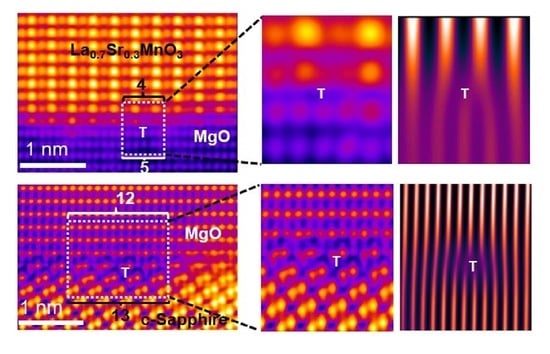Atomic-Scale Insights on Large-Misfit Heterointerfaces in LSMO/MgO/c-Al2O3
Abstract
:1. Introduction
2. Experimental Methodology
3. Results and Discussion
4. Conclusions
Author Contributions
Funding
Institutional Review Board Statement
Informed Consent Statement
Data Availability Statement
Acknowledgments
Conflicts of Interest
References
- Queisser, H.J.; Haller, E.E. Defects in Semiconductors: Some Fatal, Some Vital. Am. Assoc. Adv. Sci. 1998, 281, 945–950. [Google Scholar] [CrossRef] [PubMed]
- Mahajan, S. Defects in semiconductors and their effects on devices. Acta Mater. 2000, 48, 137–149. [Google Scholar] [CrossRef]
- Dagotto, E. Complexity in Strongly Correlated Electronic Systems. Science 2005, 309, 257–262. [Google Scholar] [CrossRef] [PubMed] [Green Version]
- Reiner, J.W.; Walker, F.J.; Ahn, C.H. Atomically Engineered Oxide Interfaces. Science 2009, 323, 1018–1019. [Google Scholar] [CrossRef]
- Jia, C.L.; Thust, A.; Urban, K. Atomic-scale analysis of the oxygen configuration at a SrTiO3 dislocation core. Phys. Rev. Lett. 2005, 95, 1–4. [Google Scholar] [CrossRef] [PubMed] [Green Version]
- Szot, K.; Speier, W.; Bihlmayer, G.; Waser, R. Switching the electrical resistance of individual dislocations in single-crystalline SrTiO3. Nat. Mater. 2006, 5, 312–320. [Google Scholar] [CrossRef] [PubMed]
- Schlom, D.G.; Chen, L.-Q.; Eom, C.-B.; Rabe, K.M.; Streiffer, S.K.; Triscone, J.-M. Strain Tuning of Ferroelectric Thin Films. Annu. Rev. Mater. Res. 2007, 37, 589–626. [Google Scholar] [CrossRef] [Green Version]
- Bowen, M.; Bibes, M.; Barthélémy, A.; Contour, J.P.; Anane, A.; Lemaıtre, Y.; Fert, A. Nearly total spin polarization in La2/3Sr1/3MnO3 from tunneling experiments. Appl. Phys. Lett. 2003, 82, 233–235. [Google Scholar] [CrossRef] [Green Version]
- Hwang, H.Y.; Cheong, S.-W.; Radaelli, P.G.; Marezio, M.; Batlogg, B. Lattice Effects on the Magnetoresistance in Doped LaMnO3. Phys. Rev. Lett. 1995, 75, 914–917. [Google Scholar] [CrossRef] [PubMed] [Green Version]
- Rasic, D.; Sachan, R.; Temizer, N.K.; Prater, J.; Narayan, J. Oxygen Effect on the Properties of Epitaxial (110) La0.7Sr0.3MnO3 by Defect Engineering. ACS Appl. Mater. Interfaces 2018, 10, 21001–21008. [Google Scholar] [CrossRef] [PubMed]
- Kim, B.; Kwon, D.; Song, J.H.; Hikita, Y.; Kim, B.G.; Hwang, H.Y. Finite size effect and phase diagram of ultra-thin La0.7Sr0.3MnO3. Solid State Commun. 2010, 150, 598–601. [Google Scholar] [CrossRef]
- Tsui, F.; Smoak, M.C.; Nath, T.K.; Eom, C.B. Strain-dependent magnetic phase diagram of epitaxial La0.67Sr0.33MnO3 thin films. Appl. Phys. Lett. 2000, 76, 2421–2423. [Google Scholar] [CrossRef]
- Vailionis, A.; Boschker, H.; Siemons, W.; Houwman, E.P.; Blank, D.H.A.; Rijnders, G.; Koster, G. Misfit strain accommodation in epitaxial ABO3 perovskites: Lattice rotations and lattice modulations. Phys. Rev. B Condens. Matter Mater. Phys. 2011, 83, 1–10. [Google Scholar] [CrossRef] [Green Version]
- Sun, J.Z.; Abraham, D.W.; Rao, R.A.; Eom, C. Thickness-dependent magnetotransport in ultrathin manganite films. Appl. Phys. Lett. 1999, 74, 3017–3019. [Google Scholar] [CrossRef] [Green Version]
- Boschker, H.; Kautz, J.; Houwman, E.P.; Siemons, W.; Blank, D.H.A.; Huijben, M.; Koster, G.; Vailionis, A.; Rijnders, G. High-Temperature Magnetic Insulating Phase in Ultrathin La0.67Sr0.33MnO3 Films. Phys. Rev. Lett. 2012, 109, 157207. [Google Scholar] [CrossRef] [Green Version]
- Sandiumenge, F.; Santiso, J.; Balcells, L.; Konstantinovic, Z.; Roqueta, J.; Pomar, A.; Espinos, J.P.; Martínez, B. Competing Misfit Relaxation Mechanisms in Epitaxial Correlated Oxides. Phys. Rev. Lett. 2013, 110, 107206. [Google Scholar] [CrossRef] [PubMed] [Green Version]
- Narayan, J.; Larson, B.C. Domain epitaxy: A unified paradigm for thin film growth. J. Appl. Phys. 2003, 93, 278–285. [Google Scholar] [CrossRef]
- Narayan, J.; Tiwari, P.; Chen, X.; Singh, J.; Chowdhury, R.; Zheleva, T. Epitaxial growth of TiN films on (100) silicon substrates by laser physical vapor deposition. Appl. Phys. Lett. 1992, 61, 1290–1292. [Google Scholar] [CrossRef]
- Yang, S.; Kuang, W.; Liou, Y.; Tse, W.; Lee, S.; Yao, Y. Growth and characterization of La0.7Sr0.3MnO3 films on various substrates. J. Magn. Magn. Mater. 2004, 268, 326–331. [Google Scholar] [CrossRef]
- Špankova, M.; Chromik, Š.; Vávra, I.; Sedláčková, K.; Lobotka, P.; Lucas, S.; Stanček, S. Epitaxial LSMO films grown on MgO single crystalline substrates. Appl. Surf. Sci. 2007, 253, 7599–7603. [Google Scholar] [CrossRef]
- Wang, C.; Zhu, Y.; Li, L.; Shen, Q.; Zhang, L. Epitaxial growth and transport property of La0.9Sr0.1MnO3 thin films deposited on MgO, LaAlO3 and SrTiO3 substrates. J. Alloy. Compd. 2017, 693, 832–836. [Google Scholar] [CrossRef]
- Štrbík, V.; Reiffers, M.; Dobročka, E.; Soltys, J.; Špankova, M.; Chromik, Š. Epitaxial LSMO thin films with correlation of electrical and magnetic properties above 400K. Appl. Surf. Sci. 2014, 312, 212–215. [Google Scholar] [CrossRef]
- Ranno, L.; Llobet, A.; Hunt, M.; Pierre, J. Influence of substrate temperature on magnetotransport properties of thin films of La0.7Sr0.3MnO3. Appl. Surf. Sci. 1999, 138-139, 228–232. [Google Scholar] [CrossRef]
- Chu, M.W.; Szafraniak, I.; Scholz, R.; Harnagea, C.; Hesse, D.; Alexe, M.; Gösele, U. Impact of misfit dislocation on the po-larization instability of epitaxial nanostructured ferroelectric perovskites. Nat. Mater. 2004, 3, 87–90. [Google Scholar] [CrossRef] [PubMed]
- Erni, R.; Rossell, M.D.; Kisielowski, C.; Dahmen, U. Atomic-Resolution Imaging with a Sub-50-pm Electron Probe. Phys. Rev. Lett. 2009, 102, 096101. [Google Scholar] [CrossRef] [PubMed] [Green Version]
- Klenov, D.O.; Stemmer, S. Contributions to the contrast in experimental high-angle annular dark-field images. Ultramicroscopy 2006, 106, 889–901. [Google Scholar] [CrossRef] [PubMed]
- Rasic, D.; Sachan, R.; Prater, J.; Narayan, J. Structure-property correlations in thermally processed epitaxial LSMO films. Acta Mater. 2019, 163, 189–198. [Google Scholar] [CrossRef]
- Moatti, A.; Sachan, R.; Gupta, S.; Narayan, J. Vacancy-Driven Robust Metallicity of Structurally Pinned Monoclinic Epitaxial VO2 Thin Films. ACS Appl. Mater. Interfaces 2019, 11, 3547–3554. [Google Scholar] [CrossRef] [PubMed]
- Moatti, A.; Sachan, R.; Narayan, J. Mechanism of strain relaxation: Key to control of structural and electronic transitions in VO2 thin-films. Mater. Res. Lett. 2019, 8, 16–22. [Google Scholar] [CrossRef] [Green Version]
- Krivanek, O.; Chisholm, M.F.; Nicolosi, V.; Pennycook, T.J.; Corbin, G.J.; Dellby, N.; Murfitt, M.F.; Own, C.S.; Szilagyi, Z.S.; Oxley, M.P.; et al. Atom-by-atom structural and chemical analysis by annular dark-field electron microscopy. Nature 2010, 464, 571–574. [Google Scholar] [CrossRef] [PubMed] [Green Version]
- Moatti, A.; Sachan, R.; Prater, J.; Narayan, J. Control of Structural and Electrical Transitions of VO2 Thin Films. ACS Appl. Mater. Interfaces 2017, 9, 24298–24307. [Google Scholar] [CrossRef] [PubMed]
- Rasic, D.; Sachan, R.; Chisholm, M.F.; Prater, J.; Narayan, J. Room Temperature Growth of Epitaxial Titanium Nitride Films by Pulsed Laser Deposition. Cryst. Growth Des. 2017, 17, 6634–6640. [Google Scholar] [CrossRef]
- Gupta, S.; Sachan, R.; Narayan, J. Evidence of weak antilocalization in epitaxial TiN thin films. J. Magn. Magn. Mater. 2020, 498, 166094. [Google Scholar] [CrossRef]
- Liu, X.-Y.; Arslan, I.; Arey, B.W.; Hackley, J.; Lordi, V.; Richardson, C.J.K. Perfect Strain Relaxation in Metamorphic Epitaxial Aluminum on Silicon through Primary and Secondary Interface Misfit Dislocation Arrays. ACS Nano 2018, 12, 6843–6850. [Google Scholar] [CrossRef]
- Zhang, Z.; Yates, J.T., Jr. Band bending in semiconductors: Chemical and physical consequences at surfaces and interfaces. Chem. Rev. 2012, 10, 5520–5551. [Google Scholar] [CrossRef] [PubMed]
- Narayan, J. Recent progress in thin film epitaxy across the misfit scale. Acta Mater. 2013, 61, 2703–2724. [Google Scholar] [CrossRef]
- Zhang, Y.; Xue, H.; Zarkadoula, E.; Sachan, R.; Ostrouchov, C.; Liu, P.; Wang, X.-L.; Zhang, S.; Wang, T.S.; Weber, W.J. Coupled electronic and atomic effects on defect evolution in silicon carbide under ion irradiation. Curr. Opin. Solid State Mater. Sci. 2017, 21, 285–298. [Google Scholar] [CrossRef]
- Gupta, A.K.; Arora, G.; Aidhy, D.S.; Sachan, R. ∑3 Twin Boundaries in Gd2Ti2O7 Pyrochlore: Pathways for Oxygen Migration. ACS Appl. Mater. Interfaces 2020, 12, 45558–45563. [Google Scholar] [CrossRef] [PubMed]
- Aidhy, D.S.; Sachan, R.; Zarkadoula, E.; Pakarinen, O.; Chisholm, M.F.; Zhang, Y.; Weber, W.J. Fast ion conductivity in strained defect-fluorite structure created by ion tracks in Gd2Ti2O7. Sci. Rep. 2015, 5, 16297. [Google Scholar] [CrossRef] [PubMed] [Green Version]
- Gupta, A.K.; Gupta, S.; Sachan, R. Laser Irradiation Induced Atomic Structure Modifications in Strontium Titanate. JOM 2021, 1–8. [Google Scholar] [CrossRef]
- Wang, Z.; Guo, H.; Shao, S.; Saghayezhian, M.; Li, J.; Fittipaldi, R.; Vecchione, A.; Siwakoti, P.; Zhu, Y.; Zhang, J.; et al. Designing antiphase boundaries by atomic control of heterointerfaces. Proc. Natl. Acad. Sci. USA 2018, 115, 9485–9490. [Google Scholar] [CrossRef] [PubMed] [Green Version]
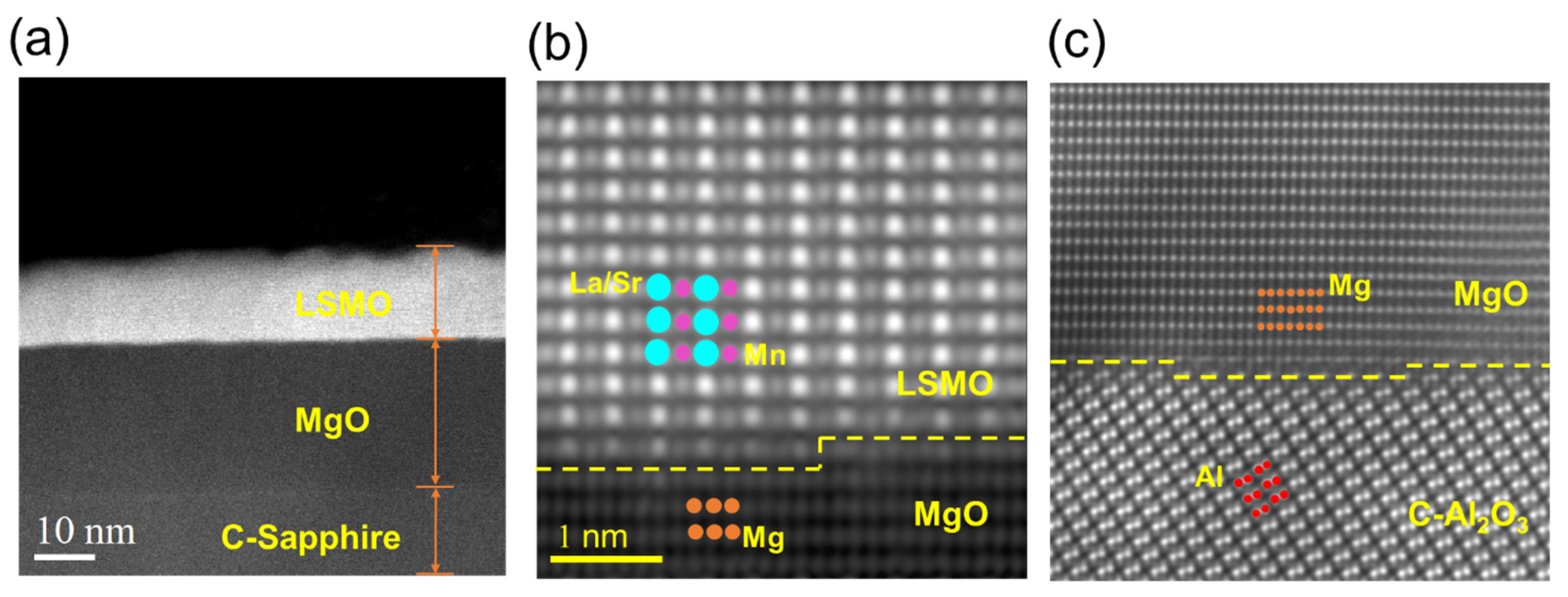
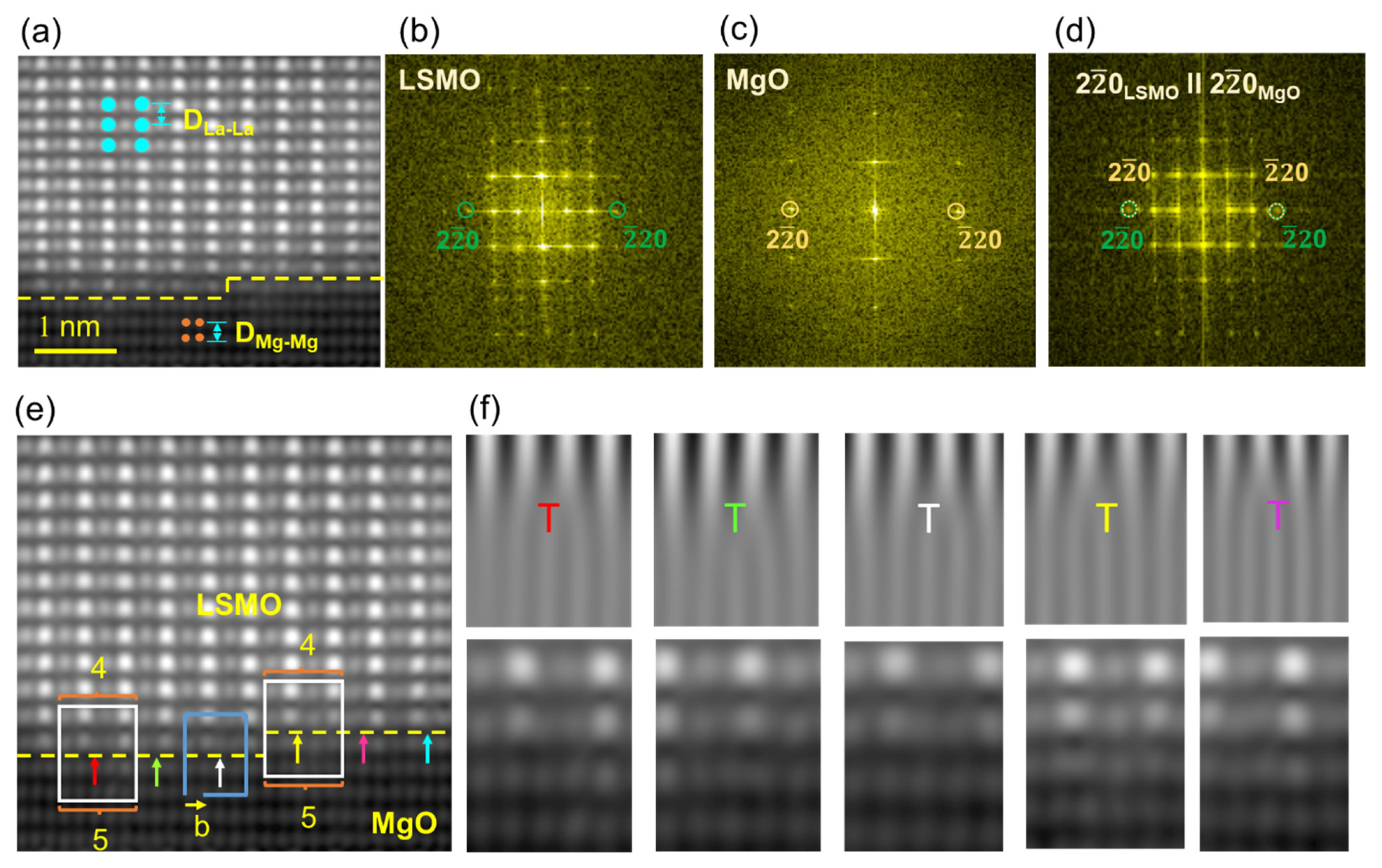
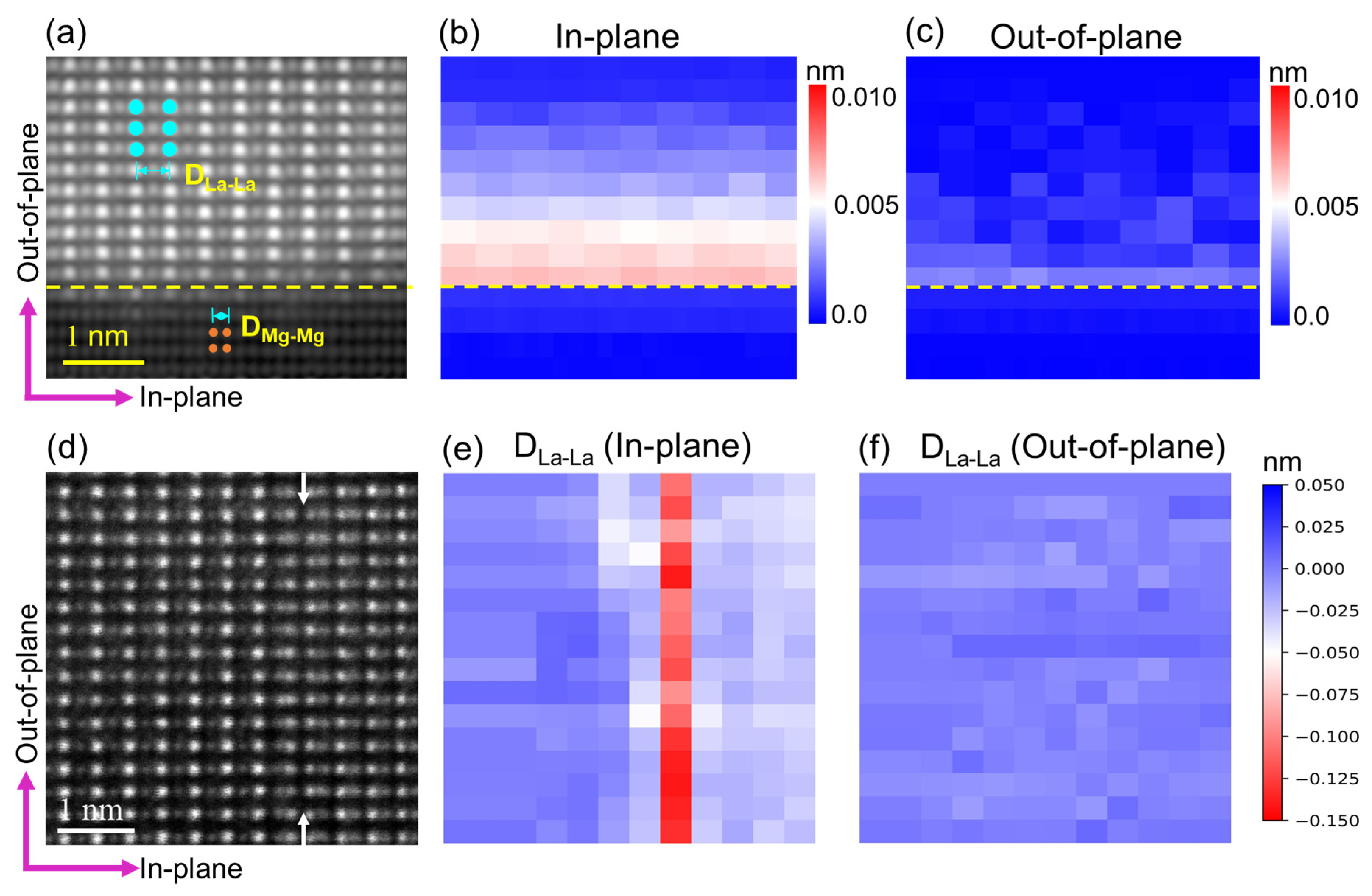
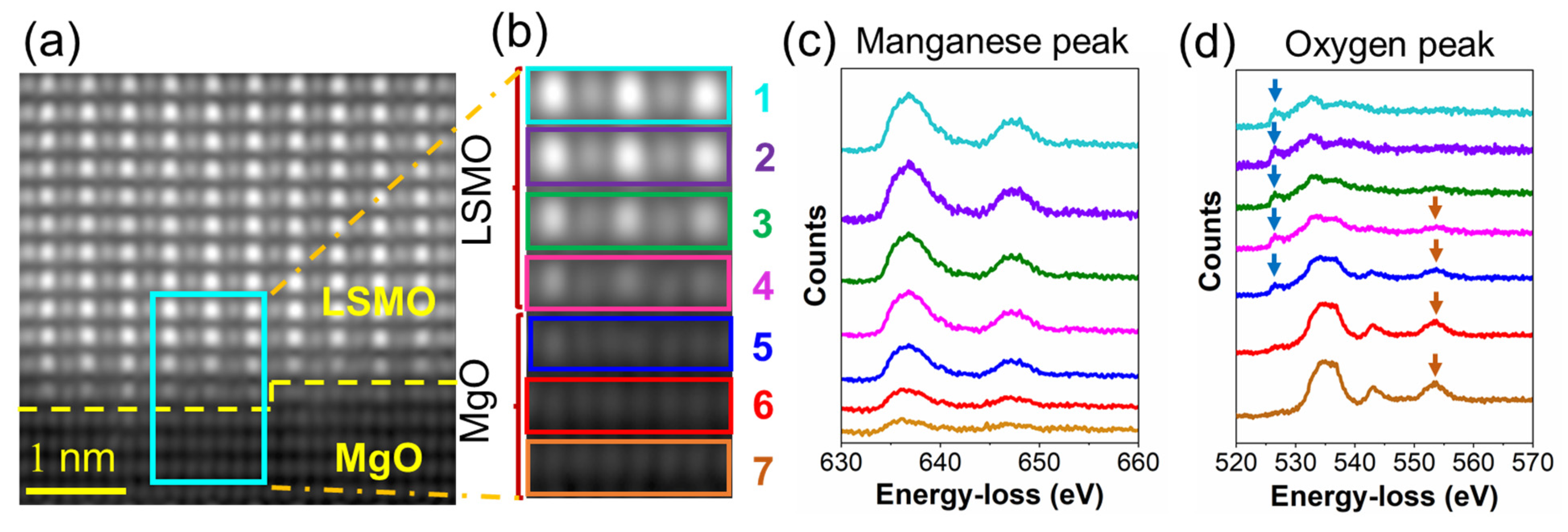
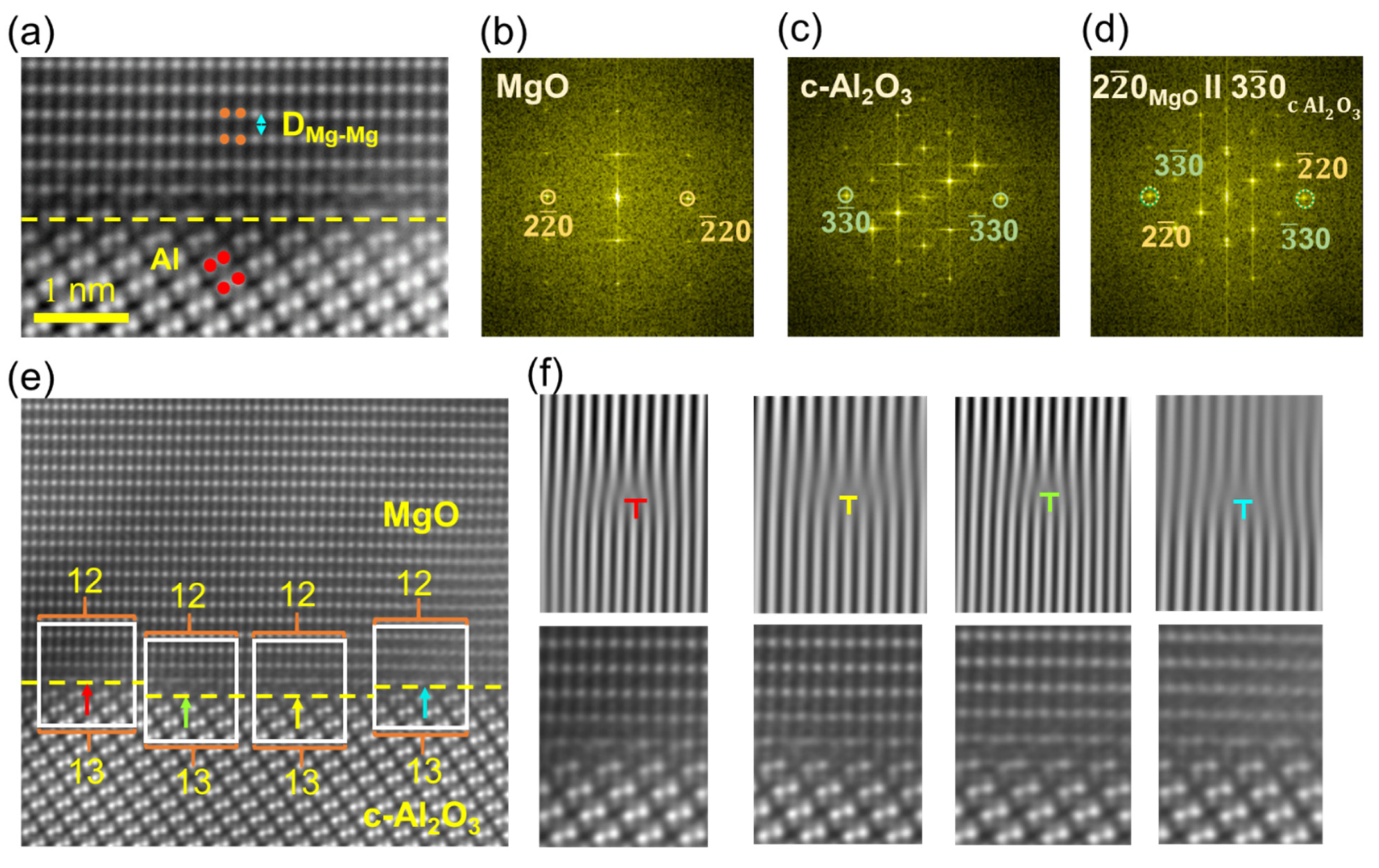

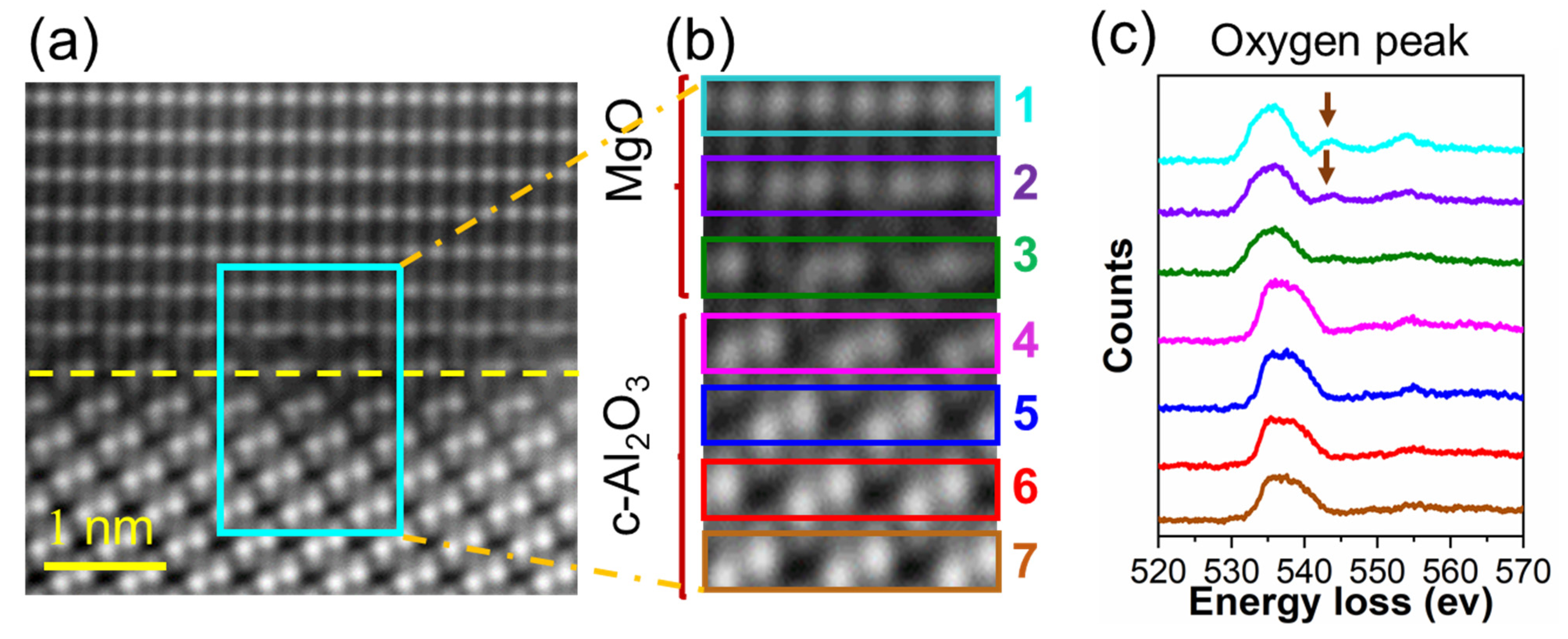
Publisher’s Note: MDPI stays neutral with regard to jurisdictional claims in published maps and institutional affiliations. |
© 2021 by the authors. Licensee MDPI, Basel, Switzerland. This article is an open access article distributed under the terms and conditions of the Creative Commons Attribution (CC BY) license (https://creativecommons.org/licenses/by/4.0/).
Share and Cite
Mandal, S.; Gupta, A.K.; Beavers, B.H.; Singh, V.; Narayan, J.; Sachan, R. Atomic-Scale Insights on Large-Misfit Heterointerfaces in LSMO/MgO/c-Al2O3. Crystals 2021, 11, 1493. https://doi.org/10.3390/cryst11121493
Mandal S, Gupta AK, Beavers BH, Singh V, Narayan J, Sachan R. Atomic-Scale Insights on Large-Misfit Heterointerfaces in LSMO/MgO/c-Al2O3. Crystals. 2021; 11(12):1493. https://doi.org/10.3390/cryst11121493
Chicago/Turabian StyleMandal, Soumya, Ashish Kumar Gupta, Braxton Hays Beavers, Vidit Singh, Jagdish Narayan, and Ritesh Sachan. 2021. "Atomic-Scale Insights on Large-Misfit Heterointerfaces in LSMO/MgO/c-Al2O3" Crystals 11, no. 12: 1493. https://doi.org/10.3390/cryst11121493
APA StyleMandal, S., Gupta, A. K., Beavers, B. H., Singh, V., Narayan, J., & Sachan, R. (2021). Atomic-Scale Insights on Large-Misfit Heterointerfaces in LSMO/MgO/c-Al2O3. Crystals, 11(12), 1493. https://doi.org/10.3390/cryst11121493






